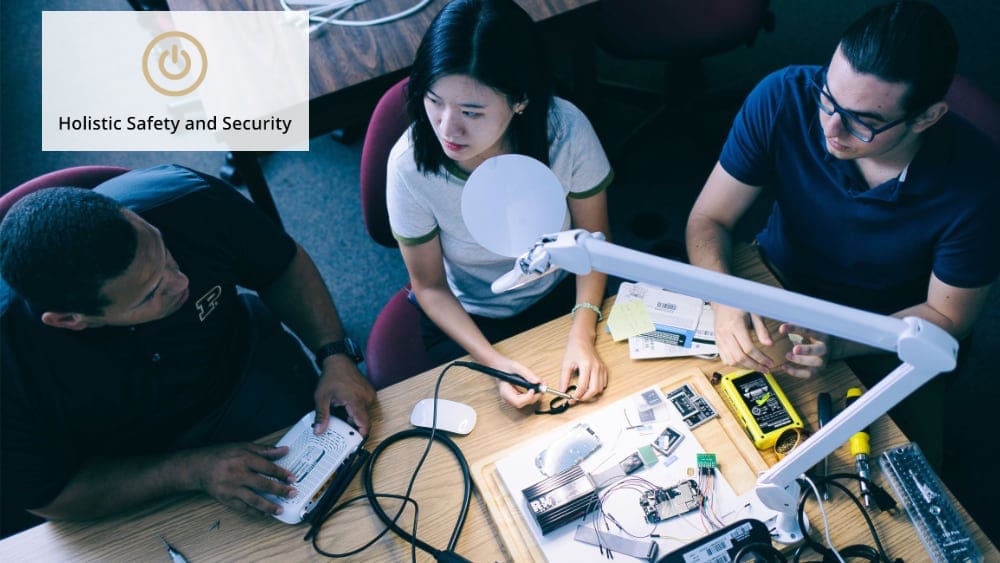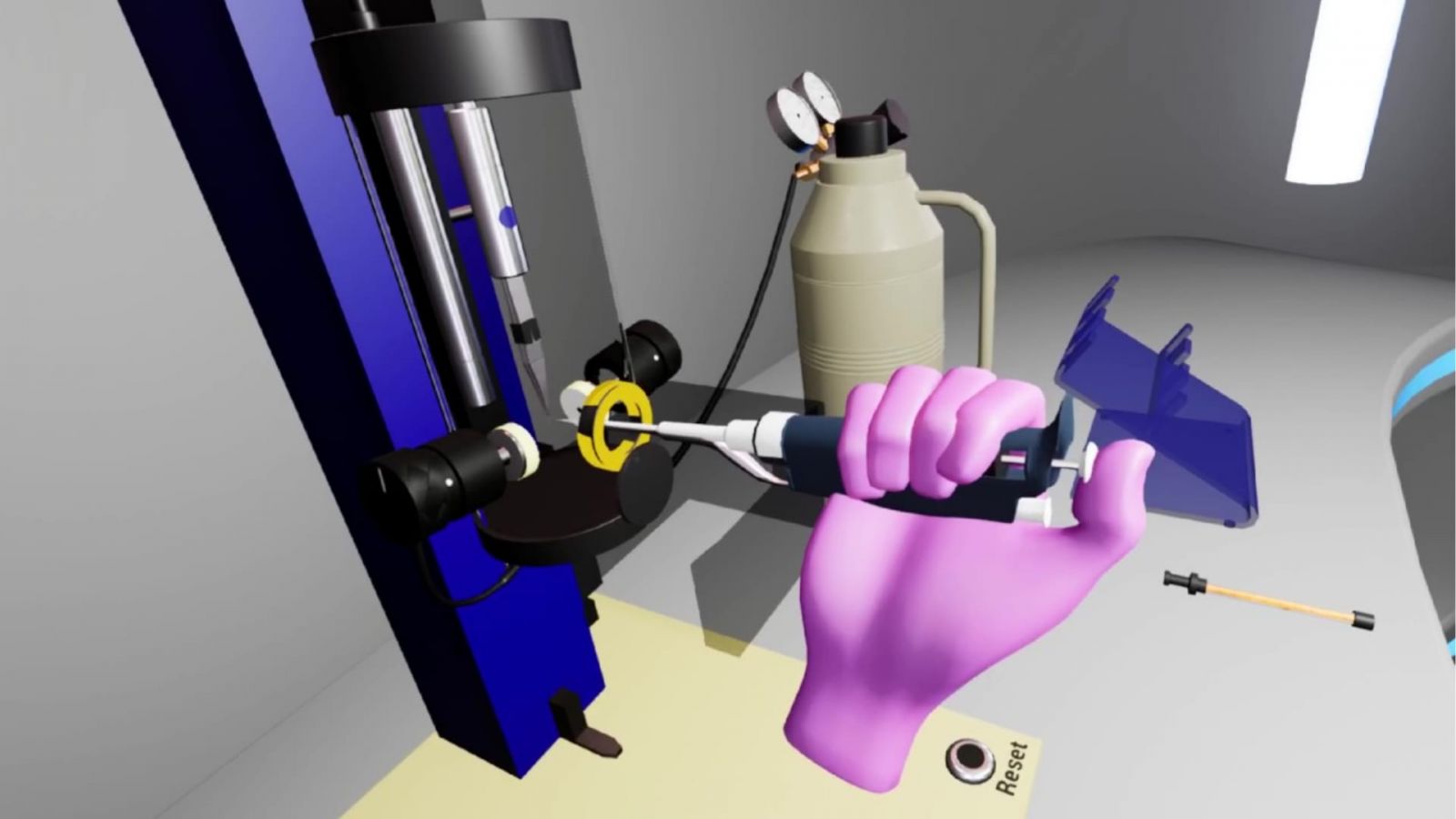This is the first of three articles describing and updating the college’s sociotechnical research impact areas for 2021-2022.

Collaborating with stakeholders in both public and private sectors, researchers in the Purdue Polytechnic’s Holistic Safety and Security (HSS) research impact team have been working to solve challenges in cybersecurity and critical infrastructure that affect global economics, security and health.
Since 2018, faculty with expertise in autonomous systems, cybersecurity, human factors, physical safety, sustainability, systems and networks, and transportation have collaborated to provide law enforcement agencies with tools for faster, more efficient incident response. They also aimed to lower the number of cyberattacks, lessening their impact to victims, and to enact evidence-based policies that contribute to safety and security.
For the 2021-2022 academic year and beyond, faculty on the research team plan to continue on the same path.
“Safety and security are important concerns in nearly every endeavor,” said Chad Laux, associate professor of computer and information technology and co-leader of the Polytechnic’s HSS research impact area. “While our focus largely remains the same, HSS has expanded to cover a broader area and to work on projects with greater impact.”
Population growth and innovation are driving increasingly complex socio-technical infrastructures. System sustainability and resiliency are needed, and there continues to be inquiry into the safety, potential threats, and security of people and systems. The research team works to bridge the gaps between theory and application.
“Many researchers in the Polytechnic have strong practical experiences from working in industry,” said Yingjie “Victor” Chen, associate professor of computer graphics technology and co-leader of the HSS research impact area. “We care not only about the science behind the technology but also about how people use the technology. That’s why safety and security are major concerns.”

Notable recent grants and projects
Laux said that HSS team members have received significant financial grants to support their research projects.
Mesut Akdere, professor of human resource development and interim associate dean for research, and Jin Wei-Kocsis and Umit Karabiyik, assistant professors of computer and information technology, were awarded a $1.5 million grant from the U.S. Department of Homeland Security for “Cyber Resilience Adaptive Virtual Reality Experiences (CRAVRE).” In partnership with the Texas A&M Engineering Extension Service, researchers are developing a virtual reality-based training program powered by artificial intelligence that will help public safety officials respond to and recover from cyber attacks created by Internet of Things (IoT) technologies.
Kate Seigfried-Spellar and Baijian “Justin” Yang, associate professors of computer and information technology, John Springer, professor of computer and information technology, and Marcus Rogers, assistant dean for cybersecurity initiatives, were awarded $400,973 by the National Institute of Justice for “FileTSAR+, an Elastic Network Forensic Toolkit for Law Enforcement.” The project is designed to complement their earlier work on FileTSAR (Toolkit for Selective Analysis & Reconstruction of Files), a free, all-in-one cybersecurity toolkit for digital forensic examiners that captures network traffic and restores digital evidence in large enterprise network settings of more than 5,000 computers.
“FileTSAR attracted law enforcement agencies from around the world,” Seigfried-Spellar said. “FileTSAR+ will be more elastic, providing benefits to agencies at state and local levels that have smaller budgets and more limited storage and back-end support capabilities.”
The Polytechnic’s Victor Chen, with Wen Jiang, professor of biological science, and their project team were awarded a total of $734,000 from the National Institute of Health for “Virtual Reality Augmented Cryo-EM Training,” a training tool to familiarize users with cryo-electron (cryo-EM) microscopy equipment such as microscopes and sample preparation equipment. Cryo-EM is a biophysical technique that can be used to determine the structure of biological macromolecules and assemblies.
Recent advances in the field are raising hopes that cryo-EM could become an important tool for drug discovery, but the spike in attention has exposed weaknesses in available training for researchers.
“By introducing new users to equipment through virtual reality (VR), expensive materials typically used in cryo-electron microscopy will not be harmed,” Chen’s research team said. “Using VR also preserves the availability of regular instruments for urgent projects during training, which has been a major hurdle. Our project brings a safe, easy to access, and cost-effective cryo-EM training tool to help new scientists become familiar with equipment.”

Holistic Safety and Security researchers also won two SaTC-EDU (Secure and Trustworthy Cyberspace) EAGER (EArly-concept Grants for Exploratory Research) grants from the National Science Foundation to study the interceptions of artificial intelligence and cybersecurity. Yang, a previous co-leader of the Polytechnic’s HSS research impact area, reported that Purdue University’s Polytechnic Institute was the only college in the United States that earned funding for two proposals.
Publications co-authored by Chen were accepted by the Conference on Computer Vision and Pattern Recognition (CVPR), a conference regarded as one of the most important in its field, and the Association for the Advancement of Artificial Intelligence’s conference. Chen’s publications were “G-Net: Spatial Granularity Net-work for Multi-Object Tracking and Segmentation” (CVPR 2021) and “DenserNet: Weakly Supervised Visual Localization Using Multi-Scale Feature Aggregation” (35th AAAI Conference on Artificial Intelligence).
“These highly ranked, impactful conferences accept fewer than one in four submissions,” said Yang, “and most submissions come from the best computer science and engineering schools in the world. Victor’s success in this research space should be celebrated.”
“Weekly writing” as a team
The Polytechnic’s HSS team members began holding a “weekly writing” group meeting, a unique solution to help them balance responsibilities as researchers at a tier one research university with their roles as professors for undergraduate students.
“We meet at a specific time and place each week to concentrate on tasks related to our research,” Seigfried-Spellar said. “It’s a dedicated time to focus quietly on writing proposals, articles, book chapters or literature reviews, with no grading or emails allowed. Team members who have participated love it, and we hope more will take advantage of the opportunity. It adds a team feel to a solo task because it’s easy to find an ear on which to bounce an idea.”
Opportunities for collaboration
Purdue Polytechnic’s continuing growth could lead to new opportunities for collaboration, the research team said.
“With many new faculty joining the college, we want to attract new members to our team,” said Chen, “and we hope the broader community will become more aware of our Holistic Safety and Security-related research.”
Additional information
- “Holistic Safety & Security” research focuses on critical infrastructure, cybersecurity (2018 summary)
- Purdue Polytechnic Strategic Research Impact Area: Holistic Safety and Security Research
- Future Work and Learning research projects focus on all human-technology interactions (part 2 of 3 in this series)
- Realizing the Digital Enterprise researchers pair technology, social responsibility (part 3 of 3 in this series)
- Purdue Polytechnic’s Strategic Research Impact Areas
- Purdue Polytechnic Office of Research
